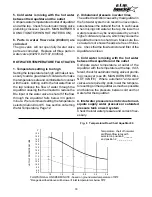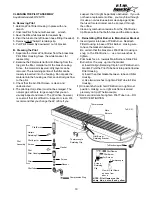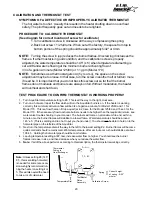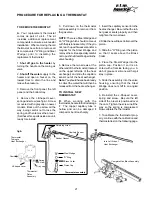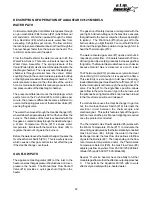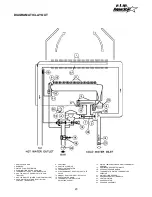
9
3. Connecting the Gas Line
In the United States: The installation must con-
form with local codes or, in the absence of local
codes, the National Fuel Gas Code ANSI Z223.
1/NFPA 54.
In Canada: The installation should conform with
CGA B149 INSTALLATION CODES and/or lo-
cal installation codes.
IMPORTANT An appliance gas pressure regula-
tor has been supplied with this unit. This regula-
tor must be installed on the gas line within 6 feet
of the heater. National Fuel Gas Code requires
that a sediment trap be installed on gas appli-
ances not so equipped. The 3/4" NPT gas inlet
elbow fitting supplied with the heater connects to
the manual gas shutoff valve with a washer gas-
ket. No pipe dope or thread tape should be used
at this joint. The 3/4" NPT side of the fitting has a
hex shoulder to help you avoid twisting the elbow
and requires pipe dope or thread tape to make
its seal. The 3/4" size is the minimum for use
with Natural Gas and must not be reduced. Pro-
pane gas line size requirements are less than
those for Natural Gas. Provided the propane gas
line is less than 20 feet and serves only the
AquaStar, it can be reduced to 5/8". When
threading the gas pressure regulator to the gas
piping, the indicator arrow on the regulator must
be pointed in the direction of gas flow.
NOTE: The regulator supplied with the
heater is an appliance level regulator de-
signed for low inlet pressure (less than 1/2
LB or 15"W.C.). DO NOT connect to an un-
regulated or high pressure propane line.
When your connections are made, check for gas
leaks at all joints (not just ones you made). Apply
some soapy water to all gas fittings and gas valve.
Soap bubbles are a sign of a leak.
NOTE: Do not apply soap solution to pilot filter
screen or pilot orifice area. If you have a leak,
shut off the gas. After verifying that required gas-
kets are in place, tighten appropriate fittings to
stop leak. Turn the gas on and check again with
a soapy solution. Never test for gas leaks using
a match or flame.
4. Connecting the water lines
Although water piping throughout your structure
may be other than copper, copper piping should
be used for at least three feet before and after
the heater (follow local codes if more stringent).
Keep water inlet pipe to at least 1/2 inch diam-
eter to allow the full flow capacity. Remember
that piping and water pressure must allow suffi-
cient flow to activate the heater when drawing hot
water from the top floor. If the hot and cold con-
nections are reversed, the heater will not func-
tion.
Fig. 3 To Disconnect Heater From Wall Hanging Strip


















